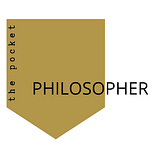Good morning friends,
On our final day of new content for the Philosophy of Mindfulness, we’re going to skip the backstory and focus on some practical reflections about how to cultivate mindfulness in your daily life. Most of today’s newsletter is inspired by this short piece from the Wildheart Meditation Center if you’d like to learn more!
My hope is that today’s newsletter will encourage us as we all work on developing our own internal self-empathy and self-compassion.
Thought
Mindfulness effectively helps us learn how to both downregulate emotional activation by shifting our attention away from distressing and ruminating thoughts, while simultaneously feeling into difficult emotions and learning how to develop distress tolerance, acceptance, and self-empathy.
—Andrew Chapman, Wildheart Meditation Center

Application
This morning we’re going to wrap up our study of Mindfulness with a short practical reflection. Specifically, I want to explore what the mindscape of one learning to become mindful looks like. Hint: it’s messy!
I so identify with the mind of a wanderer. Though I want to be one with mastery over my thoughts, it’s usually the other way around. The above quote from Andrew Chapman is so helpful and offers so much solidarity as I work to evolve in that way.
This tension between regulation and feeling is fascinating in my opinion. Without being intentional, I spend my mental energy largely on uncontrolled rumination from the past and anxieties about the future. It’s easy when practicing mindfulness to want to move in two directions: either ignoring or denying the deeper causes of our un-ease, or using mindfulness as a “trick” to fix ourselves.
Somehow neither of those approaches is super helpful, and rather mindfulness lies somewhere between those to opposite poles—that is self-denial and self-obsession.
Mindfulness is a way to temporarily step into a bird’s eye view, observe one’s emotions, explore how and why one feels the way they do, and acknowledge objectively whatever is happening.
At the heart of the un-ease that mindful practices attempt to address, is the deeply held internal state most of us have unconsciously cultivated throughout our lives. This is a state that usually orients somehow around the idea of, “I want.”
It’s the anticipation, preparation, or curation of the next moment to go the way we think we desire. This plus the compulsive rumination of past events in a self-negative light tends to dominate the human mind (you’re not alone if you identify with these patterns!)
But these patterns are largely addictive ones, formed by the biological release of hormones they trigger because of their perceived urgency.
In some ways, these patterns keep us alive and safe in the early years of life where there is so much change, dependency on caregivers, and uncertainty. But left unaddressed, they bring us intense suffering later in life when we have autonomy, freedom, and solitude.
And so the key to beginning a mindful journey is to acknowledge that this is a process we must all walk through, and show ourselves immense compassion and patience. We’re evolving in one of the most fundamental ways a person can grow!
Andrew Chapman goes on to say,
By training our attention with mindfulness, we can begin to identify where our attention wanders (e.x. to thoughts of past regret, future worry, self-critique), what type of physical, emotional, or cognitive reaction arises as a result (e.x. tight body, sad emotion, intrusive thoughts), and then how to best respond (e.x. relax and breathe into the body, acknowledge and access the emotion, care for and regulate the emotion, and allow the emotion pass without reactivating). In this regard, mindfulness is not only a skill of emotion regulation, but it is also a skill of personal accountability—allowing the practitioner to honestly, and objectively, engage with the present time experience in order to examine possible flaws in perception or reactive habits of thinking.
This process is at the heart of what practical mindfulness is all about. It’s the habit of observation—first of the emotion or thought, then of the response, and then in the acknowledgement or acceptance of that pattern.
This gentle awareness bringing is what moves us beyond our current addictive thought patterns into a state of presence and peace.
To be fair, this was an extremely brief overview, but with quite a bit of information packed in densely.
I’ll leave it here for you to reflect, ask questions, discuss with each other, and think deeper!
Please comment and share, and we’ll see you here tomorrow for our weekly rundown on the Philosophy of Mindfulness!
Have a great day friends,
Matt














Share this post